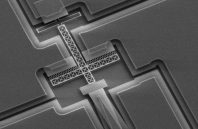For autonomous vehicles, lidar is an essential technology to recognize and detect surrounding objects. Researchers at KTH have taken aim at the key component of lidar, optical beam-stearing, and developed a device that is significantly cheaper to manufacture, lighter and more resource-efficient than previous variations of the technology. This advance could pave the way for smaller autonomous craft such as drones and robots, and help enable better profitability in the vehicle industry.
Current lidar (light detection and ranging) technology costs thousands of dollars, weighs around one kilo and consumes several watts of power.
A new version of lidar being developed at KTH Royal Institute of Technology in Stockholm is in another league altogether.
Carlos Errando-Herranz, a postdoc in the Division of Micro and Nanosystems, says that this version of lidar would cost about USD 10 each given large production volumes, weigh a few grams (including peripheral equipment) and consume some 100 milliwatts. The research was reported in the journal Optics Letters.

 (585) 768-2513
(585) 768-2513

